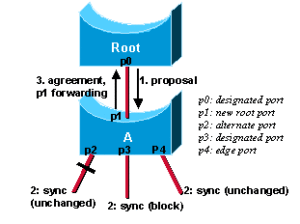
This latest quiz is focused on IPv6 with a bias to Cisco Systems. These questions are what one could expect on a CCNP or CCIE exam across various tracks. Enjoy!
IPv6 Quiz - Cisco Bias
Start
Congratulations - you have completed IPv6 Quiz - Cisco Bias.
You scored %%SCORE%% out of %%TOTAL%%.
Your performance has been rated as %%RATING%%
Your answers are highlighted below.
Question 1 |
What is the minimum MTU size that is required for an IPv6 packet?
A | 576 Bytes |
B | 1280 Bytes |
C | 1500 Bytes |
D | 1460 Bytes |
Question 1 Explanation:
While the minimum supported MTU size was 576 Bytes with IPv4, with IPv6 this minimum has increased to 1280 Bytes.
Question 2 |
What is the interface configuration mode command that is used to enable RIPng?
A | ipv6 router ripng |
B | ipv6 ripng enable |
C | ipv6 rip enable |
D | ipv6 router rip |
Question 2 Explanation:
RIP (like other IPv6 routing protocols) is enabled on the interface, this is done with the ipv6 rip name enable command. The ipv6 router rip name command is used to change process-wide variables (like maximum paths). Another example is OSPF. This is configured under an interface with ipv6 ospf 1 area 0, for example. Notice the process ID is set to 1 and the area is the backbone (0).
Question 3 |
Which of the following command would correctly permit SSH traffic from any IPv6 source to the 2001::/64 network?
A | permit tcpv6 2001::/64 any eq ssh |
B | permit tcpv6 any 2001::/64 eq ssh |
C | permit tcp 2001::/64 any eq ssh |
D | permit tcp any 2001::/64 eq ssh |
Question 3 Explanation:
IPv6 ACL statements are very similar to IPv4 ACL statements except wildcard marks are not used; in this case the permit tcp any 2001::/64 eq ssh statement accomplishes the goals, allowing traffic from any source to pass to the 2000::/64 network over SSH.
Question 4 |
What is the command that is used to enable an IPv6 DHCP Relay Agent?
A | ipv6 helper-address ipv6-address |
B | ipv6 forwarding-address ipv6-address |
C | ipv6 dhcp relay ipv6-address |
D | ipv6 dhcp relay destination ipv6-address |
Question 4 Explanation:
The need for a DHCP relay agent with IPv6 is the same as it is with IPv4; the configuration is slightly different but the operation is similar at a high level. The ipv6 dhcp relay destination ipv6-address command is used on the router that connects to the client segment and points to the unicast address of the DHCP server.
Question 5 |
What is the name of the feature that can be used to translate between an outside IPv6 global prefix to an inside unique local or separate global prefix?
A | NAT-PT |
B | NAT66 |
C | NPTv6 |
D | NAT64 |
Question 5 Explanation:
The Network Prefix Translation (NPTv6) feature is used to translate between an outside IPv6 global prefix to an inside unique local or separate global prefix.
Question 6 |
Which of the following DNS record types resolves hostnames into IPv6 addresses?
A | CNAME |
B | NS |
C | MX |
D | AAAA |
Question 6 Explanation:
A Hosts (AAAA) record is used to resolve a Fully Qualified Domain Name (FQDN) to a IPv6 address.
Once you are finished, click the button below. Any items you have not completed will be marked incorrect.
Get Results
There are 6 questions to complete.
← |
List |
→ |
Return
Shaded items are complete.
| 1 | 2 | 3 | 4 | 5 |
| 6 | End |
Return
You have completed
questions
question
Your score is
Correct
Wrong
Partial-Credit
You have not finished your quiz. If you leave this page, your progress will be lost.
Correct Answer
You Selected
Not Attempted
Final Score on Quiz
Attempted Questions Correct
Attempted Questions Wrong
Questions Not Attempted
Total Questions on Quiz
Question Details
Results
Date
Score
Hint
Time allowed
minutes
seconds
Time used
Answer Choice(s) Selected
Question Text
All done
Need more practice!
Keep trying!
Not bad!
Good work!
Perfect!
Share this:
- Click to share on LinkedIn (Opens in new window)
- Click to share on Reddit (Opens in new window)
- Click to share on Twitter (Opens in new window)
- Click to share on Facebook (Opens in new window)
- Click to share on Pinterest (Opens in new window)
- Click to share on Tumblr (Opens in new window)
- Click to share on Telegram (Opens in new window)
- Click to share on WhatsApp (Opens in new window)
- Click to share on Pocket (Opens in new window)
- Click to print (Opens in new window)
- Click to email a link to a friend (Opens in new window)

